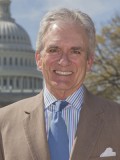
 By Executive Director J. Brent Walker
By Executive Director J. Brent Walker
A group calling itself the Legislative Clergy Council is spearheading a prayer-in-school movement and held a gathering on the National Mall dubbed “Worship in Washington 2016” to call for the return of prayer to the public schools.
Their motivating assumption – perhaps in good faith – is that, when they took prayer out of school in 1962, schools and culture went into a downward spiral. They cite – without any substantiation – that since then violent crime and murder have increased 544 percent, divorce 300 percent, pregnancies 187 percent, and so on — one horrible statistic after another.
This tired argument suffers many dubieties. First, it’s a classic post hoc ergo propter hoc (“after this, therefore because of this”) logical fallacy. Just because two events (even assuming they are true) occur one after another does not mean the first caused the latter. The rooster’s crowing at dawn does not make the sun come up! Second, many states discontinued government-sponsored prayer and devotional Bible reading long before the 1960s. The Illinois Supreme Court, for example, struck down official religious exercise in 1910. Others did away with mandating school prayer on policy grounds. Third, the truth be known, state-sponsored prayer unfortunately continues to this day in parts of the country.
So, trying to blame the supposed decline of Western Civilization on one Supreme Court decision in 1962 is laughingly wrongheaded – all the more when one realizes that the Court’s ban of state-sponsored prayer actually preserved voluntary, student-initiated prayer. Vital religious experience must be voluntary and free; state-sponsored religion is always coercive at worst and rote at best.
The start of a new school year provides an opportunity to unpack the many ways religion can properly be exercised, studied and otherwise included on public school campuses, while keeping school officials out of the business of officiating religious exercises or even promoting religion in general.
Here are some reminders of what can be done:
• Students may pray – alone or in a group, silently or even out loud – as long as it is voluntary, non-disruptive and respects the rights of other students not to participate.
• Students may form religious clubs in secondary schools when other non-curriculum related groups are allowed. Outside adults may not lead or regularly attend club meetings, and teachers may be present only to monitor the meetings.
• Students may display and communicate religious messages – on their clothing and orally – in the same way other messages are allowed. Generally, they may wear religious garb, such as yarmulkes and headscarves, as well.
• Students may distribute religious literature, under the same rules as other material may be distributed. This right is subject to reasonable time, place and manner restrictions, such as requiring material to be placed on a table rather than handed out.
• Students may speak to and persuade other students about religious topics, including inviting them to religious services and events. But, such speech cannot be allowed to turn into religious harassment. A “no thanks” must end the conversation.
• Students are allowed to include religious themes in their schoolwork and homework assignments, as long as those religious references are germane to the assignment.
• Students may learn about religion where the topic naturally arises in the curriculum. The teaching should be academic, not devotional, and pursue an educational goal. In other words, schools may expose students to religious views but may not impose any particular view.
• A religious holiday may be an occasion to teach about that particular religion, but not celebrated as a religious event. Along the same lines, religious music may be played or sung and sacred artwork observed and appreciated as long as it serves an educational goal.
• Students may be excused from lessons that are objectionable based on religious convictions, and they must be excused if the school does not have a compelling interest in requiring all students to participate.
• Teachers and other school personnel may meet with one another for Bible study and prayer, as long as such gatherings are voluntary and outside the classroom (in the teachers’ lounge, for example) during lunch breaks or other free time.
These are but a few of the many ways religion may be included in the school day that are culturally sensitive and constitutionally sound. They are vital and volitional religious experiences that may do the students some real good.
What we don’t need is a return to the days where the government – through state actors like teachers – tell our children when, where and what to pray.
Click here for more information on religion in the public schools.
From the July/August 2016 edition of Report from the Capital. You can also read the digital version of the magazine or view it as a PDF.




